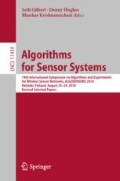Abstract
We study the uniform dispersal problem (also called the filling problem) in arbitrary connected areas. In the filling problem robots are injected one-by-one at \(k \ge 1\) Doors into an unknown area, subdivided into cells. The goal is to cover the area, i.e. each cell must be occupied by a robot. The robots are homogeneous, anonymous, autonomous, have limited visibility radius, limited persistent memory, and silent, i.e. do not use explicit communication. A fundamental question is how ‘weak’ those robots can be in terms of hardware requirements and still be able to solve the problem, which was initiated by Barrameda et al. [4]. In our previous paper [11] we presented an algorithm which solves the filling problem for orthogonal areas with O(1) bits of persistent memory, 1 hop visibility range and without explicit communication. The algorithm utilized the timing of movements and had O(n) runtime, where n is the number of cells in the area. In this paper, we generalize the problem for silent robots for an arbitrary connected area represented by a graph, while maintaining the 1 hop visibility range. The algorithm is collision-free, it terminates in \(O(k \cdot \varDelta \cdot n)\) rounds, and requires \(O(\varDelta \cdot \log k)\) bits of persistent memory, where \(\varDelta \) is the maximum degree of the graph.
Access this chapter
Tax calculation will be finalised at checkout
Purchases are for personal use only
References
Albers, S., Kursawe, K., Schuierer, S.: Exploring unknown environments with obstacles. Algorithmica 32(1), 123–143 (2002)
Albers, S., Henzinger, M.R.: Exploring unknown environments. SIAM J. Comput. 29(4), 1164–1188 (2000)
Augustine, J., Moses Jr., W.K.: Dispersion of mobile robots: a study of memory-time trade-offs. In: Proceedings of the 19th International Conference on Distributed Computing and Networking, ICDCN 2018, pp. 1:1–1:10 (2018)
Barrameda, E.M., Das, S., Santoro, N.: Deployment of asynchronous robotic sensors in unknown orthogonal environments. In: Fekete, S.P. (ed.) ALGOSENSORS 2008. LNCS, vol. 5389, pp. 125–140. Springer, Heidelberg (2008). https://doi.org/10.1007/978-3-540-92862-1_11
Barrameda, E.M., Das, S., Santoro, N.: Uniform dispersal of asynchronous finite-state mobile robots in presence of holes. In: Flocchini, P., Gao, J., Kranakis, E., Meyer auf der Heide, F. (eds.) ALGOSENSORS 2013. LNCS, vol. 8243, pp. 228–243. Springer, Heidelberg (2014). https://doi.org/10.1007/978-3-642-45346-5_17
Brass, P., Cabrera-Mora, F., Gasparri, A., Xiao, J.: Multirobot tree and graph exploration. IEEE Trans. Robot. 27(4), 707–717 (2011)
Bullo, F., Cortés, J., Marttınez, S.: Distributed algorithms for robotic networks. In: Applied Mathematics Series. Princeton University Press (2009)
Cohen, R., Peleg, D.: Local spreading algorithms for autonomous robot systems. Theoret. Comput. Sci. 399(1), 71–82 (2008)
Das, S., Flocchini, P., Prencipe, G., Santoro, N., Yamashita, M.: Autonomous mobile robots with lights. Theoret. Comput. Sci. 609, 171–184 (2016)
Flocchini, P., Prencipe, G., Santoro, N.: Distributed Computing by Oblivious Mobile Robots. Synthesis Lectures on Distributed Computing Theory. Morgan & Claypool Publishers, San Rafael (2012)
Hideg, A., Lukovszki, T.: Uniform dispersal of robots with minimum visibility range. In: Fernández Anta, A., Jurdzinski, T., Mosteiro, M.A., Zhang, Y. (eds.) ALGOSENSORS 2017. LNCS, vol. 10718, pp. 155–167. Springer, Cham (2017). https://doi.org/10.1007/978-3-319-72751-6_12
Hsiang, T.-R., Arkin, E.M., Bender, M.A., Fekete, S.P., Mitchell, J.S.B.: Algorithms for rapidly dispersing robot swarms in unknown environments. In: Boissonnat, J.-D., Burdick, J., Goldberg, K., Hutchinson, S. (eds.) Algorithmic Foundations of Robotics V. STAR, vol. 7, pp. 77–93. Springer, Heidelberg (2004). https://doi.org/10.1007/978-3-540-45058-0_6
Acknowledgment
This work was partly performed in the frame of FIEK_16-1-2016-0007 project, implemented with the support provided from the National Research, Development and Innovation Fund of Hungary, financed under the FIEK_16 funding scheme.
Author information
Authors and Affiliations
Corresponding author
Editor information
Editors and Affiliations
Rights and permissions
Copyright information
© 2019 Springer Nature Switzerland AG
About this paper
Cite this paper
Hideg, A., Lukovszki, T., Forstner, B. (2019). Filling Arbitrary Connected Areas by Silent Robots with Minimum Visibility Range. In: Gilbert, S., Hughes, D., Krishnamachari, B. (eds) Algorithms for Sensor Systems. ALGOSENSORS 2018. Lecture Notes in Computer Science(), vol 11410. Springer, Cham. https://doi.org/10.1007/978-3-030-14094-6_13
Download citation
DOI: https://doi.org/10.1007/978-3-030-14094-6_13
Published:
Publisher Name: Springer, Cham
Print ISBN: 978-3-030-14093-9
Online ISBN: 978-3-030-14094-6
eBook Packages: Computer ScienceComputer Science (R0)

